 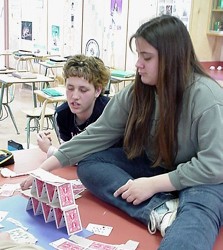 Science 7 & 8 students were learning about structures, and how some designs can provide more support than others. They were experimenting with various playing-card tower designs. Let's look at the forces inside structures and materials, and the effect these forces have on the world around us.
Science 7 & 8 students were learning about structures, and how some designs can provide more support than others. They were experimenting with various playing-card tower designs. Let's look at the forces inside structures and materials, and the effect these forces have on the world around us.
Building Design: Like a house of cards, some buildings will fall over very easily if there is an earthquake. Building designers attempt to make their designs stronger by distributing the forces evenly into the ground. Before we can examine this more closely, we'll have to define some words that we'll need to use. A Force is a push or a pull. Gravity is a force; it causes things to have weight. A building's weight is a force which pushes towards the ground. Friction is a force that occurs between surfaces. It acts against the direction of motion, and is often the reason why things don't move. A building is very heavy. The entire weight must be supported by walls, which transmit the force into the ground. The more interior walls there are, the less force each wall must support, and the more spread out the force becomes. 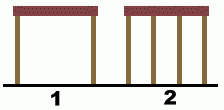 In the card house, the weight of each floor piece is distributed downwards through pairs of vertical walls. This spreads out the force among many walls, so each wall doesn't have to support too much weight.  But there's another problem. Support walls don't have much sideways strength all by themselves, especially if you join them together at the ends. They are easily bent or broken, if sideways forces (like in an earthquake) are applied. But there's another problem. Support walls don't have much sideways strength all by themselves, especially if you join them together at the ends. They are easily bent or broken, if sideways forces (like in an earthquake) are applied.Also, don't forget that these walls will also be supporting many floors ... horizontal surfaces which will apply their own sideways forces during an earthquake. In the card house at the right, friction helps to keep the walls from sliding sideways (notice the increased friction provided by paper towel!), but in a real building we need more than that. Vertical walls can also also be made less vulnerable to sideways forces by connecting them together. 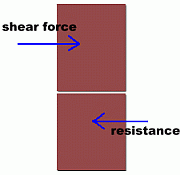 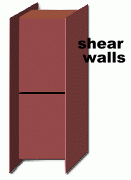 Vertical walls in a building that are meant to absorb sideways forces from many horizontal floors are called shear walls.
Unlike the card house, where the resistance is provided by friction, the shear walls of a building are designed to absorb horizontal movement through secure attachments, by attaching walls to floors using bolts. Vertical walls in a building that are meant to absorb sideways forces from many horizontal floors are called shear walls.
Unlike the card house, where the resistance is provided by friction, the shear walls of a building are designed to absorb horizontal movement through secure attachments, by attaching walls to floors using bolts.An I-beam, used for horizontal support, directly transfers sideways forces to the vertical wall it is attached to. The floor itself, along with the I-beams that support it, help to stabilize the shear walls, and prevent them from moving laterally. 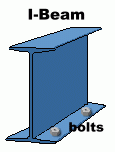 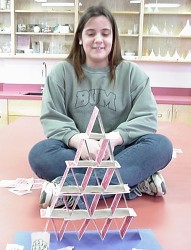
In our house of cards, a similar effect could be achieved by using tape to secure each wall to the floor above and below. Then your structure would be very stable. A house of cards, however, has its own special characteristics. First of all, it is difficult to build because the friction between the end of one card and the surface of another is very small. The means that any small sideways force that is inadvertently applied (from a shaking hand, or an air current, or a sneeze) will overcome the friction, and a card will slide. The result will be a good illustration of the other feature of a house of cards ... one card out of place will cause the entire structure to come tumbling down. This happens once again because of the small frictional forces involved ... one card can't easily stand by itself. Falling down 'like a house of cards' isn't something you want a building to do. Fortunately, except in extreme circumstances, as in the World Trade Center collapse, most shear walls and floors are tied together so tightly that this won't happen. Forces like this also occur in nature. All material is made from smaller particles. Sometimes one set of particles provides a framework that supports other particles, within the substance, and can be weakened by sideways forces. Find out more on our page about thixotropic materials. |